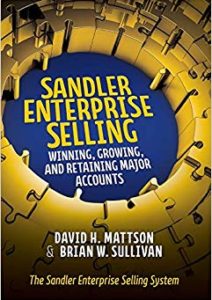We’re all familiar with brainstorming and its many forms. The collaborative process of creatively solving problems is generally credited to Alex Osborn, a US advertising executive. His book, Applied Imagination, detailed the teaming approach that he used to win business with firms like GE, Chrysler and DuPont. He figured out that in dealing with the multitude of problems in such major accounts, a process could be a huge competitive advantage.
Today, with team selling so fundamental in working with enterprise accounts, collaborative brainstorming aligns beautifully. It’s a good thing, too, because major clients expect you to understand their business and to address their issues quickly. And given that they typically account for substantial proportions of a selling organization’s business, they believe they’ve earned that right.
Beyond solving problems, enterprise accounts present another challenge. For they are vast ecosystems of opportunity – teeming fields of rich, fertile soil. With a successful track record of service and, yes, problem-solving, you earn the right to plant the seeds of growth in that soil. Major accounts are marketplaces in and of themselves and most selling organizations effectively strategize growing them. But some don’t place specific focus on growth and seeking new opportunities and, as such, they do a disservice to the time and effort it took to win the business in the first place. And the disservice applies to the entire selling organization and its stakeholders, who depend on revenue and profitability growth. As for sales team members themselves, whose compensation is directly at stake, their suffering is personal. But the biggest loser if you don’t make every effort to grow an enterprise account? The account itself. For they chose you among other good options, investing in you as their partner. And now they depend on you to deliver increasing value by going deep and wide in their ecosystem with your portfolio of products and services. They don’t want you to be a one-off. This is the enterprise selling mindset. If you play in this space, it must be your mindset as well. Truthfully, it’s your duty.
Are there obstacles? Of course. There’s the hand-off from sales to delivery, often done effectively by some organizations with strong engagement between sales and delivery after the initial win. But others employ the “detach with an ax” philosophy, with sales exiting to slay the next dragon as the delivery team focuses intently on deliverables. What typically happens? Darwin gets the last word. Remember Natural Selection? Organisms better adapted to their environments survive and produce more offspring. Those not adapted, in the world of major accounts, are replaced by the competition. Often quickly.
I mentioned duty. How does brainstorming help you fulfill it to your constituencies, most importantly, to your account? By helping you to creatively focus not only on problems but opportunities. All the typical brainstorming guidelines apply – creative structure, rapid development, invested parties, supportive environments, etc. But in addition to brainstorming problem statements like “How to recover from the failed ABC project”, effective organizations also attack opportunity statements like “How to grow our business in the DEF program”.
In Sandler Enterprise Selling, we believe strongly in a practical and powerful brainstorming process called Team Storm. Imagine assembling 10-12 team members in a structured brainstorming session focused on a specific opportunity. And think about wrapping up, 60 minutes later, with 3-4 concrete action items with due dates and individual accountability to advance the opportunity. Sound like a productive way to spend an hour? And we strongly advocate the involvement of delivery team members in Team Storm sessions. These valuable teammates are often overlooked when it comes to account growth although they’re often the most informed people about account happenings. With the organizations that are the very best at “land and expand” strategies, it’s often difficult to distinguish between the sales team and delivery team members. Why? Because these organizations don’t draw lines between the two, believing and executing on the “one team” concept – the “account team”.
What if there’s not a specific opportunity area to exploit in a brainstorming session? In and of itself, such a situation is incredibly fertile ground for a session based on an opportunity statement like “How to identify new growth areas in GHI account”. Team Storm events built on such wide open, opportunistic themes, welcoming creative ideas from invested people, in my experience, are often the most productive sessions of all.
So, engage in problem-solving and brainstorm to build creative solutions. But to stimulate real growth, accelerate the opportunity-solving as well! All your team members will benefit but the real gain will be for your clients, who have likely been depending on you to deliver added value for a long time. They might even decide to keep you around for a while.













Comments (2)
This article gives a brief understanding of brainstorming problems and opportunities. It is beneficial to read this article.
The article is so beneficial